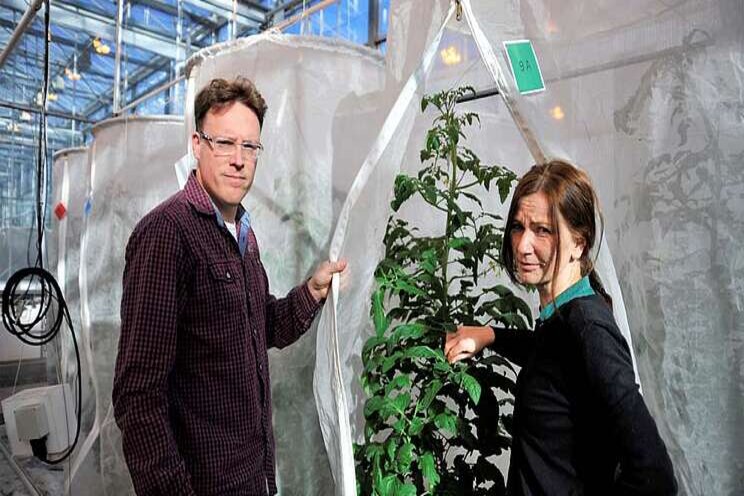New predatory bug limits establishment of Nesi in tomato
Added on 09 January 2020

In recent years the bug Nesidiocoris tenuis has become a serious problem in tomato growing. Although it controls whitefly and tomato leaf miner, the insect causes so much damage to the crop that growers tend to view it as a pest rather than a predator. These Mediterranean plunderers puncture fruits and flowers and cause necrotic rings which lead to stems breaking off. They inhibit plant growth, resulting in deformed plants. Tips fall off and production stagnates.
"Tomato growers in southern Europe have been using Nesi to control Tuta absoluta for years," says researcher Gerben Messelink of Wageningen University & Research's greenhouse horticulture business unit in Bleiswijk, the Netherlands. "Various other predators such as nematodes and parasitic wasps have been tried as well, but Nesi appears to be the most effective. Southern Spanish growers therefore mainly see this creature as a useful predator."
But things are different hundreds of kilometres to the north, where Nesi is a serious problem for Dutch tomato growers. Crop damage is severe and the predatory bug is difficult to control selectively. Chemicals also have an adverse effect on Macrolophus, a relative of Nesi, giving pests such as whitefly free rein and disrupting the whole biological control system in the greenhouse. What's more, this creature develops faster than related species. "It is a thermophilic insect, so when the temperature in the greenhouse is 20°C the population is already growing strongly," Messelink says.
Omnivores in a spectrum
To tackle this problem, in 2015 WUR teamed up with the growers' organisation LTO Glaskracht Nederland and submitted a project proposal, "Pest control with omnivorous predatory bugs". This public-private partnership launched in 2016, financed half by the Dutch Ministry of Agriculture and half by the private sector. The private funding for this project comes from the Dutch tomato, gerbera and rose growers' cooperatives, Stichting Programmafonds Glastuinbouw (the Dutch greenhouse horticulture programme fund foundation) and Koppert Biological Systems.
"Nesi is a predatory bug in the Miridae family, just like Macrolophus," Messelink explains. "Miridae are omnivores that not only use plants as food but also serve as predators. There are many different species of Miridae and they are all located in different places in this spectrum. One species eats more plant, the other more prey. Macrolophus is a predatory bug that is very pest-oriented and only causes limited damage to plants. Nesi, on the other hand, quickly causes a lot of damage but is also a good pest controller."
Messelink and his colleague Ada Leman ran a greenhouse trial last year in which they investigated whether establishment of this insect in tomato is limited if a population of other bugs is already established in the crop. To determine whether Nesi also affects the densities of its relatives, controls with these bugs without the notorious predator were also set up.
Insect cages
The greenhouse trial was carried out in large insect cages with one tomato plant per cage: grafted Brioso plants with two stems. The effect was assessed using three types of new predatory bug, which the researchers brought in from southern Europe. "We investigated the effect these three species had on pest control and we looked at the development and establishment of these insects in tomato and their secondary effects on Nesi. The result was quite spectacular," the researcher says. "Nesi was able to establish in all treatments, but what we saw was that where we had built up a population with the new species first before introducing Nesi, establishment was reduced by an average of 90%."
The final population density of the predatory bug among its three southern European cousins averaged 85%, 92% and 95% lower than the controls respectively. There was no significant effect the other way round.
Whitefly and cotton whitefly
"We confirmed in the laboratory that the adults of the three new species feed on the young Nesi nymphs, but it is not yet clear what effect Macrolophus has on the insect," Messelink says. "We have observed that Macrolophus is often squeezed out in the greenhouse, and in the laboratory too we have noticed that this bug doesn't feed on young Nesi nymphs. So using these new species could offer an advantage over Macrolophus. But it's important to find out whether they are just as effective in controlling the main pests."
Now that the researchers have established that the three southern European bugs control tomato leafminer, this year they are looking into the effect these species have on greenhouse whitefly and tobacco whitefly.
Standing army
Messelink is enthusiastic about the initial result. "You have to view the predatory bugs as a standing army. If you can deploy the new species preventively, if they can control different pests, tackle Nesi and don't damage the crops, then we will be taking a big step forward in biological control."
At the end of the day, the researchers want to be able to offer growers a total package. "We are looking for a predatory bug that controls an infestation as effectively as possible and doesn't damage the crop," Messelink says. "I have high hopes. I think these insects will be a big help in biological control in the future."
Experience in rose and gerbera
As part of the same study, the researchers also investigated the use of omnivorous predatory bugs in gerbera and rose. "We think that this insect can offer a solution in these crops too," researcher Gerben Messelink says.
"Whitefly, caterpillar, Echinothrips - all these pests can be controlled with predatory bugs, so it is possible but we still need to do more research. We have observed that this insect has difficulty establishing in gerbera, mainly because of the mildew control technique that's currently used. Growers spray the crop, and it is not so much the toxic value that eliminates the predator; research has shown that spraying under high pressure 'blows away' the predator. So if we can find another way of controlling mildew, we can also build up a population of predatory bugs in the crop and control pests that way."
The researchers are also trialling building up a population of these predators in rose. "Rose is a woody plant, which makes it difficult for this insect to establish. Bugs prefer hairy, herbaceous plants. But we might be able to keep these predators in the crop by using a host plant, for example. We have already demonstrated that we can control Echinothrips in rose effectively this way."
Source and photo courtesy of In Greenhouses
Source: In Greenhouses
More news















